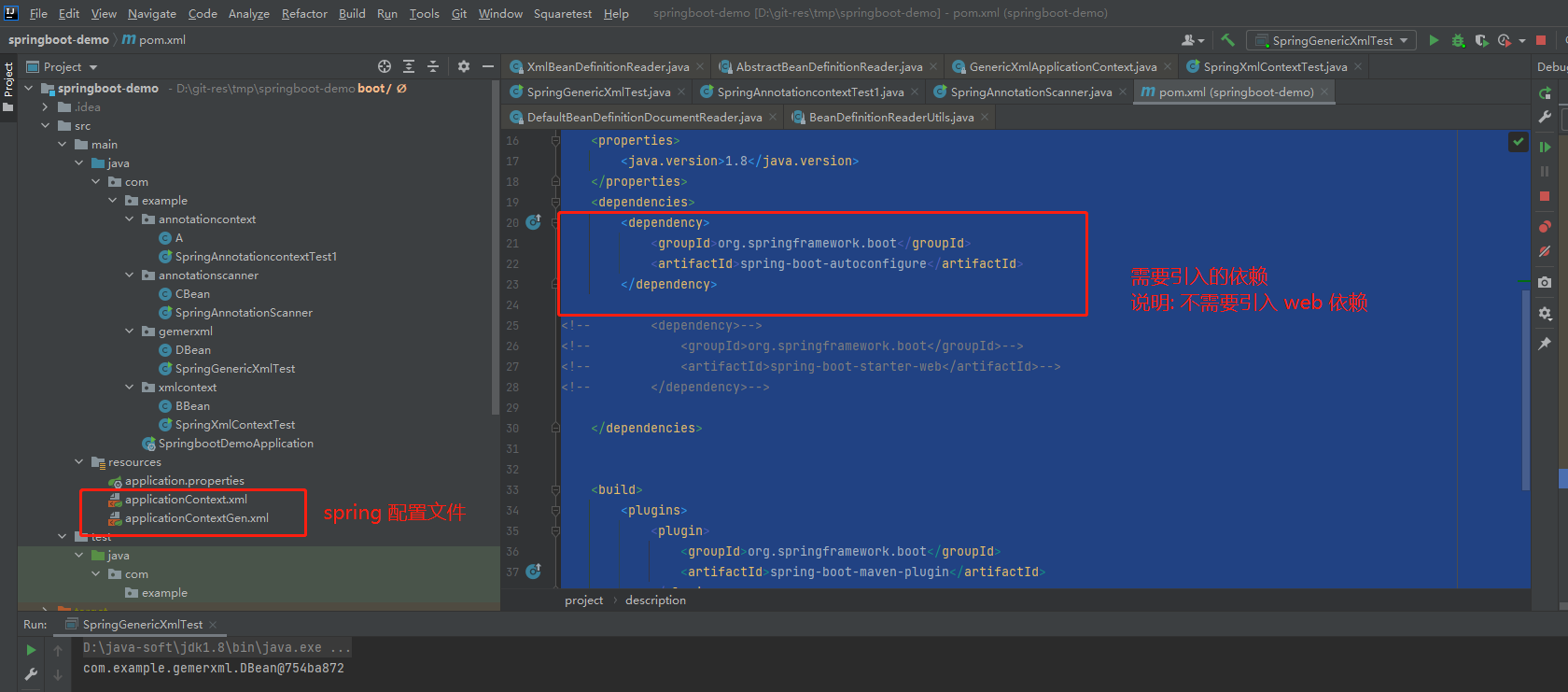spring5上下文对象创建方式
前置说明
测试环境使用的是 springboot 项目 , 没有 web 依赖
pom.xml
<?xml version="1.0" encoding="UTF-8"?>
<project xmlns="http://maven.apache.org/POM/4.0.0" xmlns:xsi="http://www.w3.org/2001/XMLSchema-instance"
xsi:schemaLocation="http://maven.apache.org/POM/4.0.0 https://maven.apache.org/xsd/maven-4.0.0.xsd">
<modelVersion>4.0.0</modelVersion>
<parent>
<groupId>org.springframework.boot</groupId>
<artifactId>spring-boot-starter-parent</artifactId>
<version>2.3.4.RELEASE</version>
<relativePath/> <!-- lookup parent from repository -->
</parent>
<groupId>com.example</groupId>
<artifactId>springboot-demo</artifactId>
<version>0.0.1-SNAPSHOT</version>
<name>springboot-demo</name>
<description>Demo project for Spring Boot</description>
<properties>
<java.version>1.8</java.version>
</properties>
<dependencies>
<dependency>
<groupId>org.springframework.boot</groupId>
<artifactId>spring-boot-autoconfigure</artifactId>
</dependency>
</dependencies>
<build>
<plugins>
<plugin>
<groupId>org.springframework.boot</groupId>
<artifactId>spring-boot-maven-plugin</artifactId>
</plugin>
</plugins>
</build>
</project>
项目示例

ClassPathApplicationContext
package com.example.xmlcontext;
import org.springframework.context.ApplicationContext;
import org.springframework.context.support.ClassPathXmlApplicationContext;
public class SpringXmlContextTest {
public static void main(String[] args) {
ApplicationContext ac = new ClassPathXmlApplicationContext("applicationContext.xml");
BBean bBean1 = ac.getBean(BBean.class);
System.out.println(bBean1);
BBean bBean2 = (BBean) ac.getBean("bBean");
System.out.println(bBean2);
System.out.println("获取的两个对象是否相等 : "+ (bBean1==bBean2));
}
}
GenericXmlApplicationContext
package com.example.gemerxml;
import org.springframework.context.support.GenericXmlApplicationContext;
public class SpringGenericXmlTest {
public static void main(String[] args) {
GenericXmlApplicationContext ac = new GenericXmlApplicationContext("classpath:applicationContextGen.xml");
DBean bean = ac.getBean(DBean.class);
System.out.println(bean);
}
}
AnnotationConfigApplicationContext(1)
基于 this 进行扫描
package com.example.annotationcontext;
import org.springframework.context.annotation.AnnotationConfigApplicationContext;
import org.springframework.context.annotation.ComponentScan;
import org.springframework.context.annotation.Configuration;
@Configuration
@ComponentScan(basePackages = "com.example.annotationcontext")
public class SpringAnnotationcontextTest1 {
public static void main(String[] args) {
AnnotationConfigApplicationContext ac = new AnnotationConfigApplicationContext(SpringAnnotationcontextTest1.class);
A bean = ac.getBean(A.class);
System.out.println(bean);
}
}
AnnotationConfigApplicationContext(2)
基于扫描包进行扫描
package com.example.annotationscanner;
import org.springframework.context.ApplicationContext;
import org.springframework.context.annotation.AnnotationConfigApplicationContext;
public class SpringAnnotationScanner {
public static void main(String[] args) {
AnnotationConfigApplicationContext ac = new AnnotationConfigApplicationContext("com.example.annotationscanner");
CBean bean = ac.getBean(CBean.class);
System.out.println(bean);
}
}
.example.annotationscanner");
CBean bean = ac.getBean(CBean.class);
System.out.println(bean);
}
}